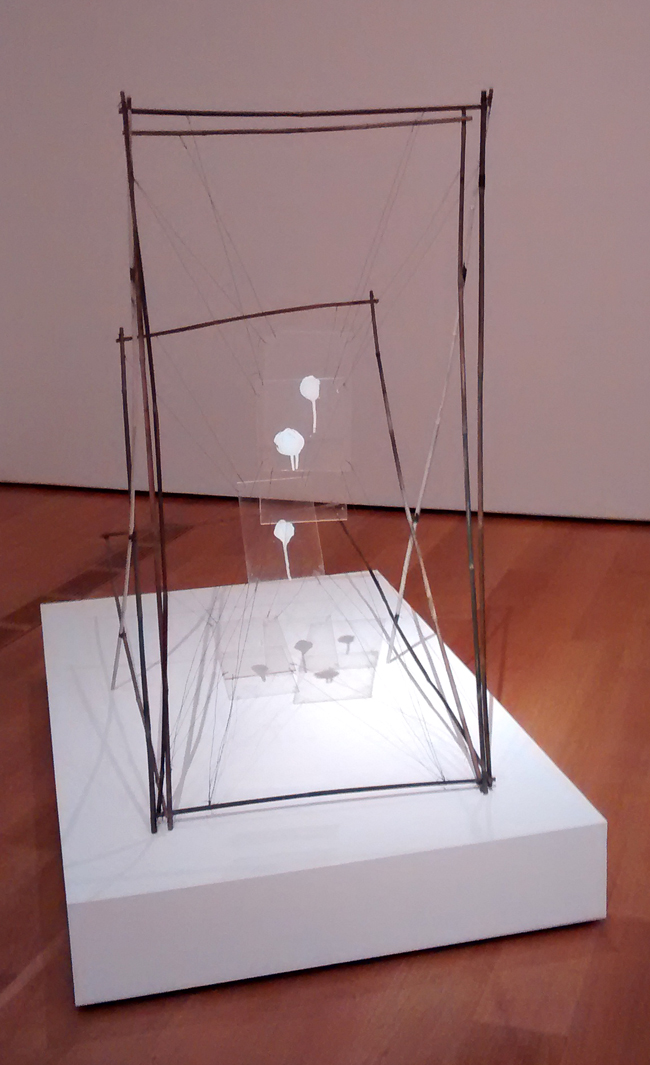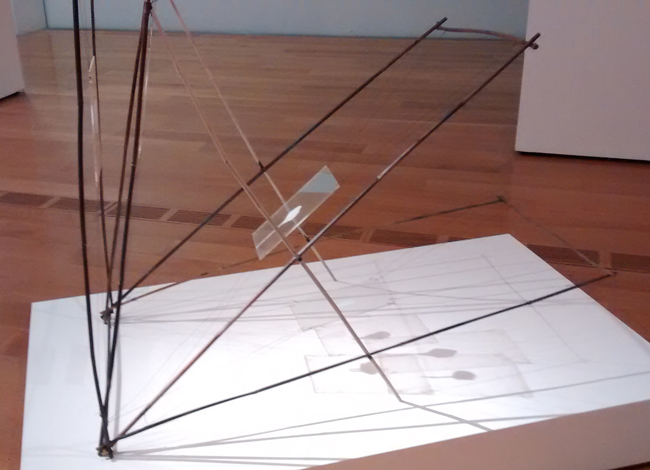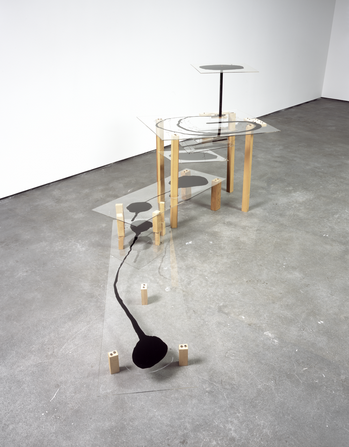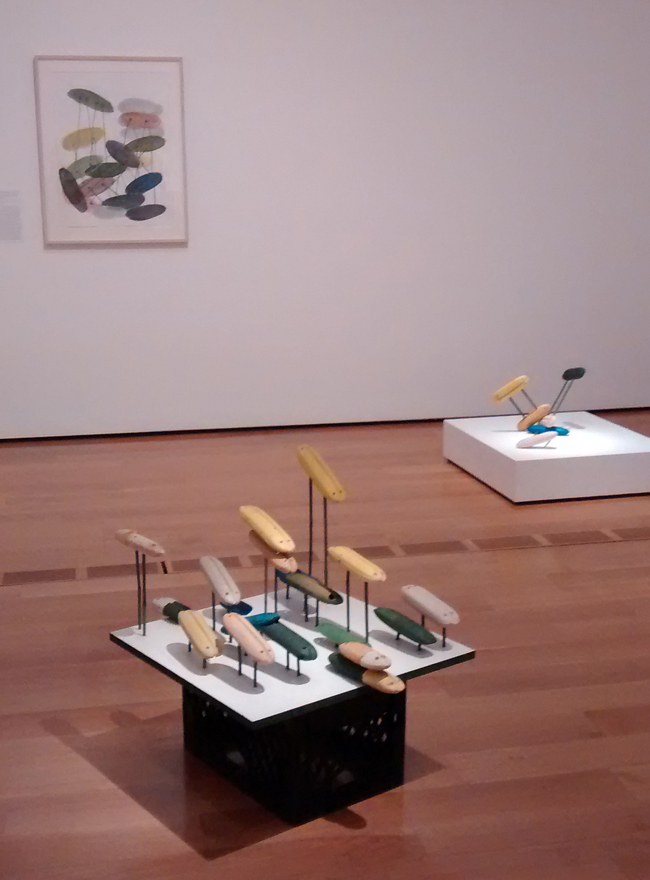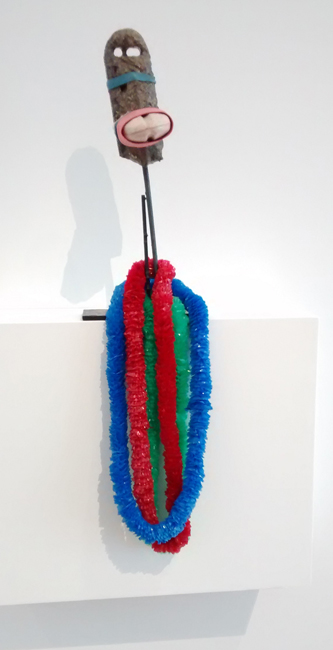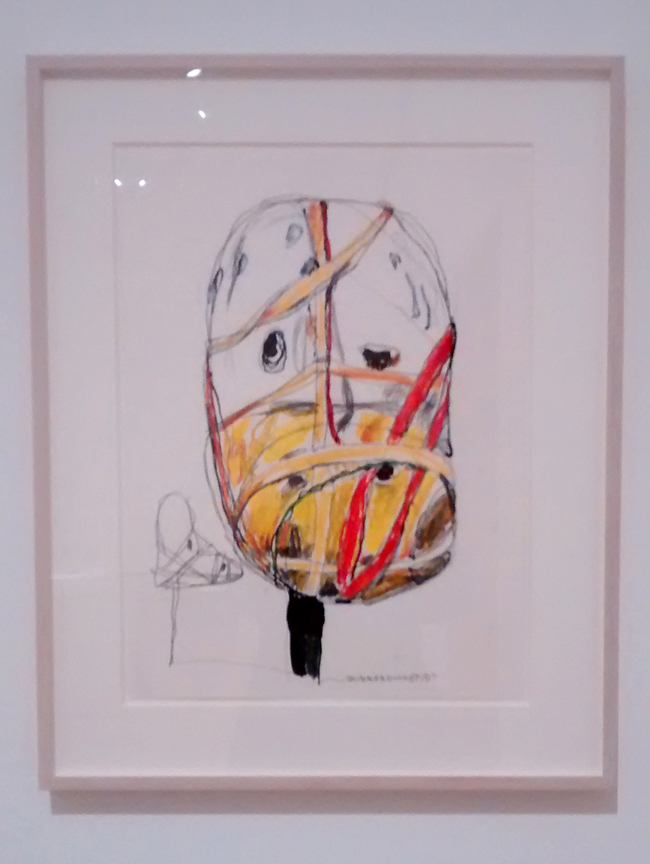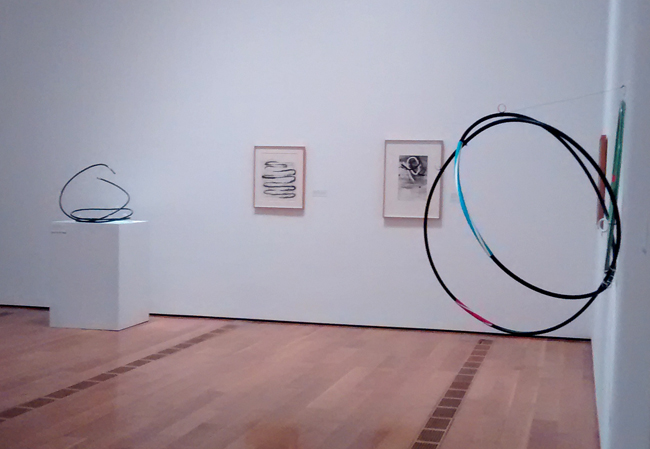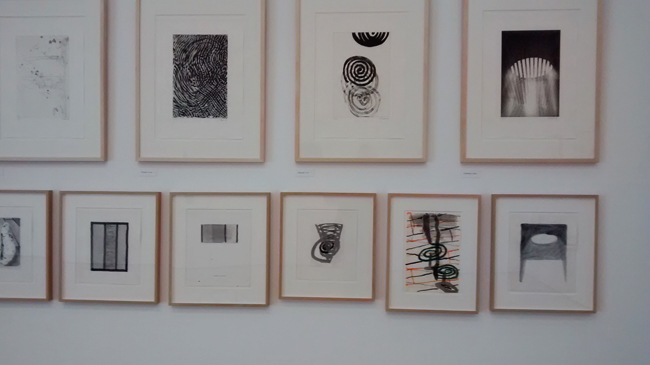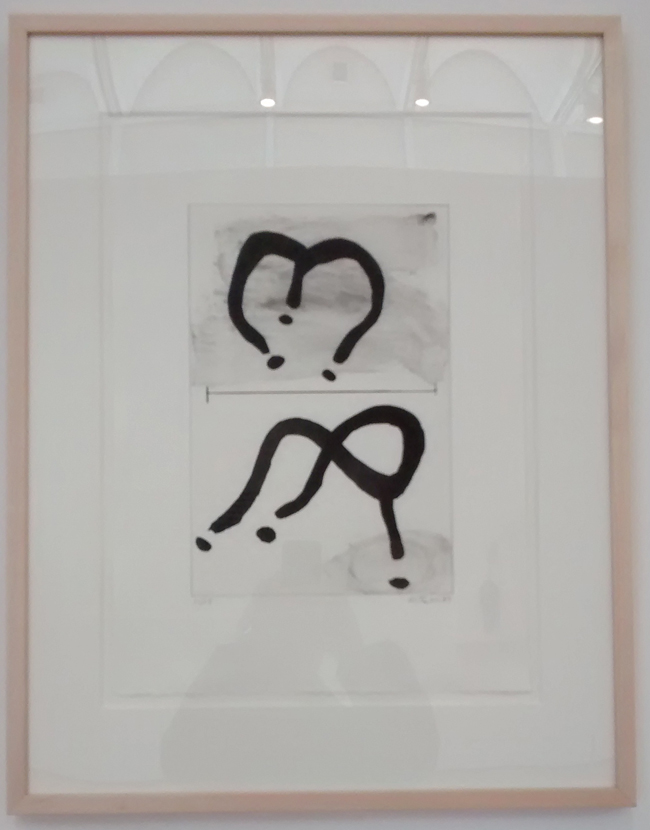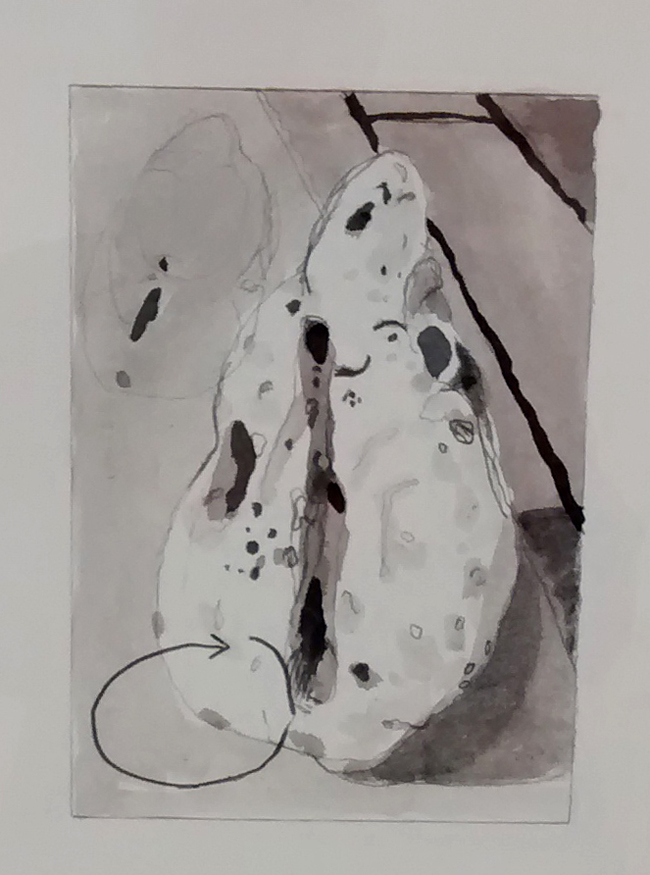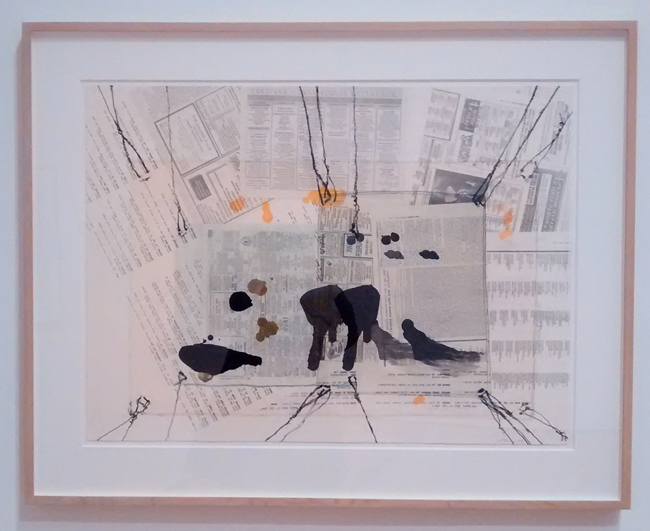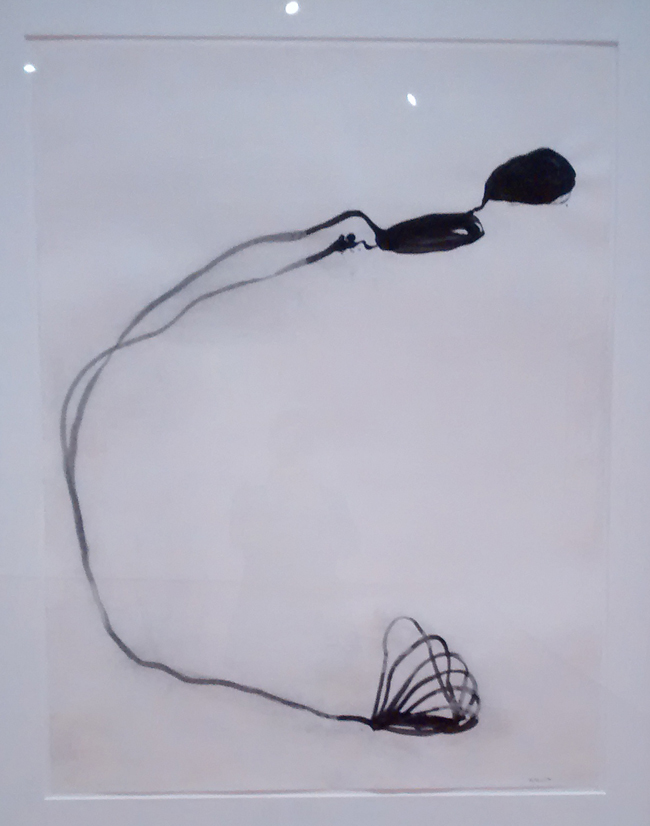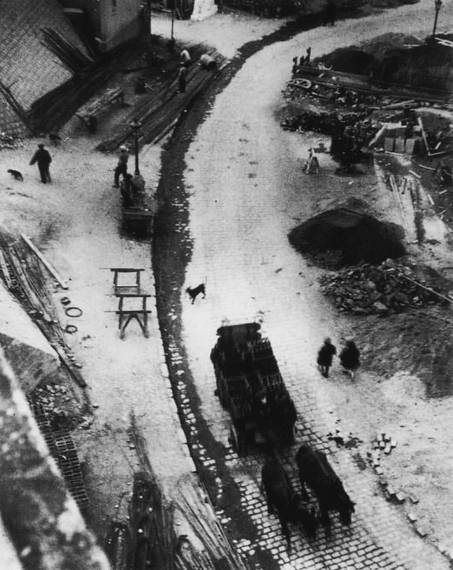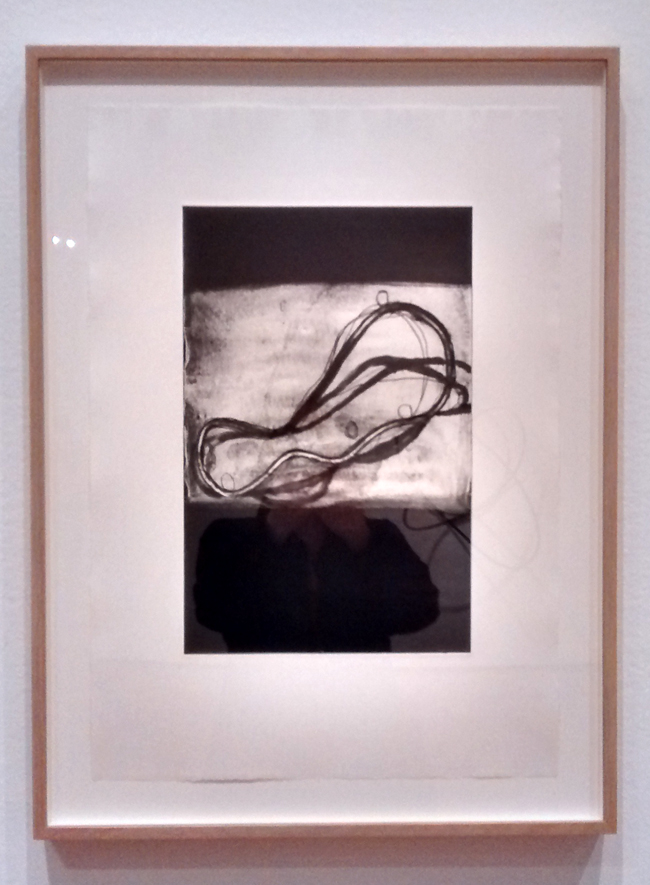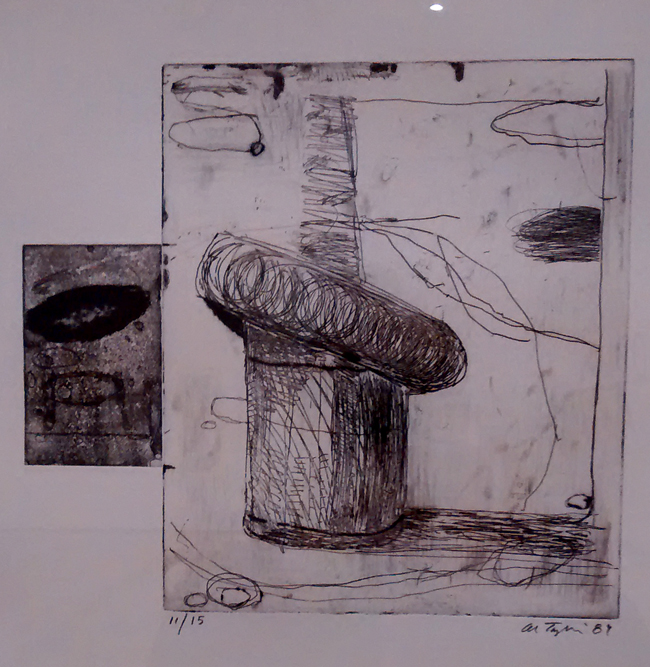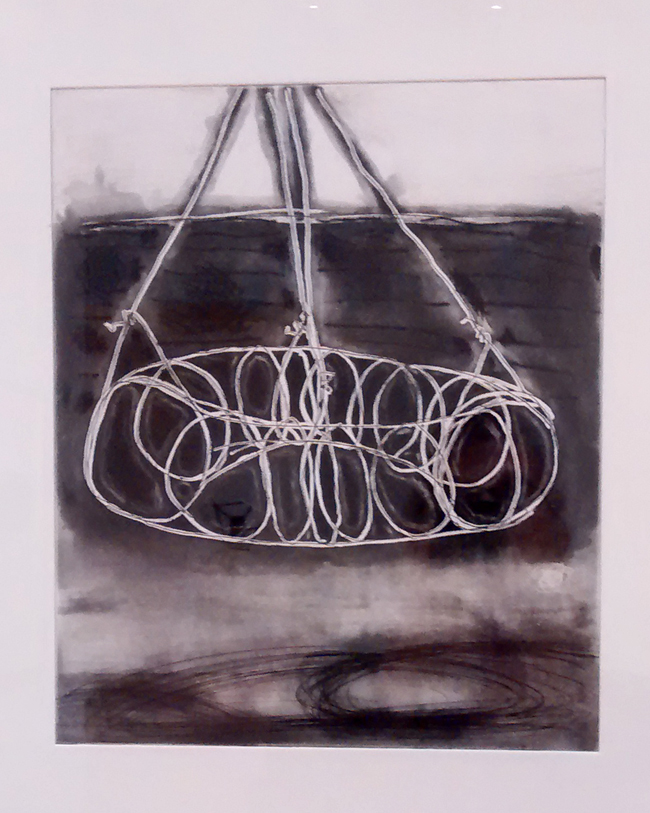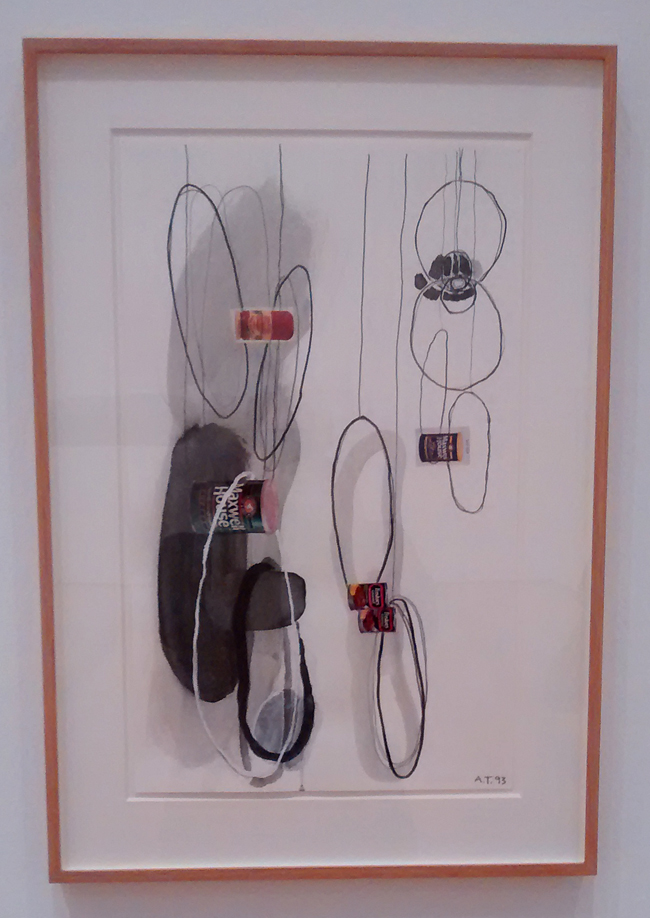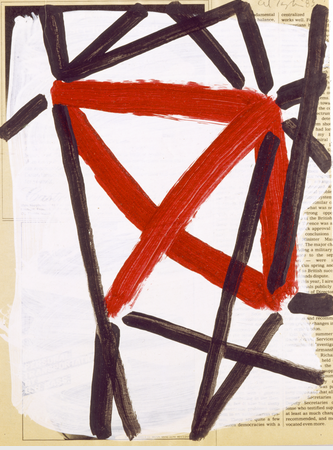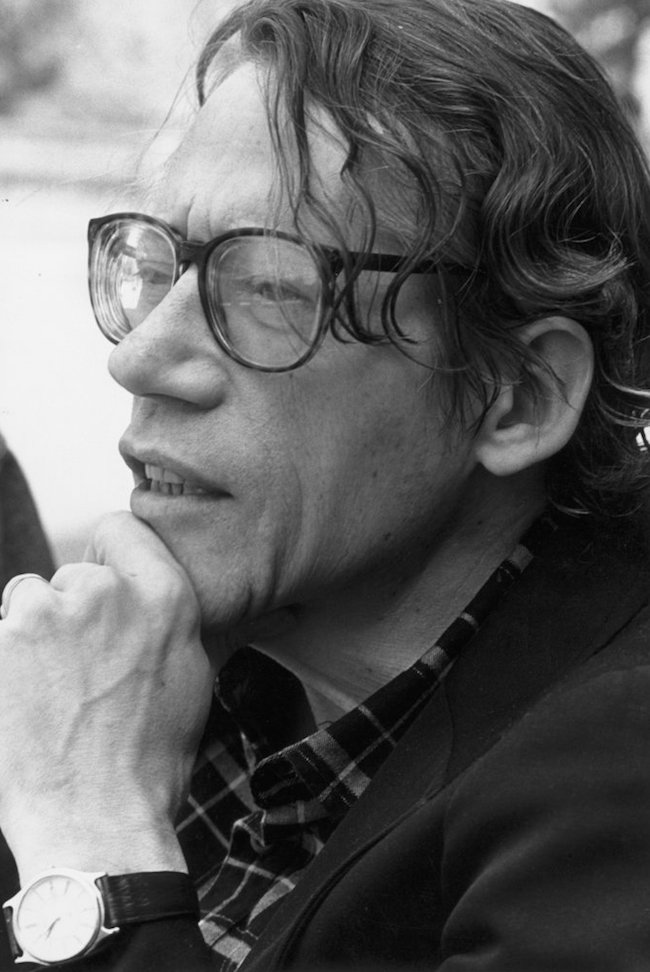Ending March 18th, Al Taylor, What are You Looking At? is a fascinating and entertaining exhibit. Exquisitely curated by the High’s Michael Rooks, I didn’t expect all three floors of the museum’s Anne Cox Chambers wing to be devoted to this idiosyncratic artist who died far too young at age 51 in 1999. Taylor’s proficiency at printmaking, sophisticated spatial sense and his droll sense of humor fuels the exhibit, drawing the viewer into his strolls along urban streets and his keen observational skills. Does anyone ever think about repurposing pet excrement? Taylor was able to achieve elegance in his Tinguely inspired constructions and sculptures that feature just that subject matter- or maybe Rube Goldberg is a more appropriate mentor.
If you’re normally bored or infuriated by text accompanying imagery, you won’t be at this show. Wall text thoughtfully informs without presuming to unveil the soul of the artist or his innermost objectives. It allows our own imaginations to be stimulated and teased by the artwork.
Pet Stain Removal Device, 1989. Bamboo garden stakes, Plexiglas, enamel paint, wire and electrical tape. The Estate of Al Taylor, Courtesy David Zwirner, New York/London
From the High’s website: “The High Museum of Art is organizing the first museum survey in the United States to explore the career of American artist Al Taylor (1948–1999). With more than 150 sculptures, drawings, and prints drawn from several of the artist’s major series over nearly two decades, the exhibition will reveal the crisscrossing avenues of Taylor’s artistic inquiry and his innovative use of unexpected materials.”
The exhibition features works from Taylor’s series Wheel Studies (1981–1985), Latin Studies (1984–1985), Pet Stains and Puddles (1989–1992), Pass the Peas (1991), X-Ray Tube (1995), Full Gospel Neckless (1997), and Bondage Duck (1998–99), among others.
Black Piece (for Etienne-Jules Marey), 1990. Plexiglas, enamel paint, China Marker grease pencil, wood and wire. The Estate of Al Taylor, Courtesy David Zwirner, New York/London. Photo courtesy High Museum.
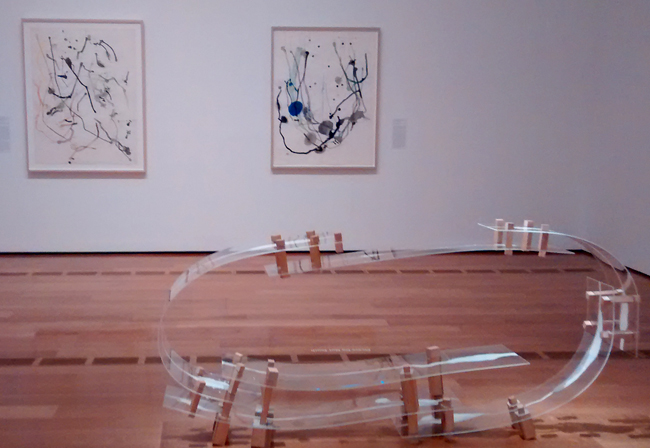
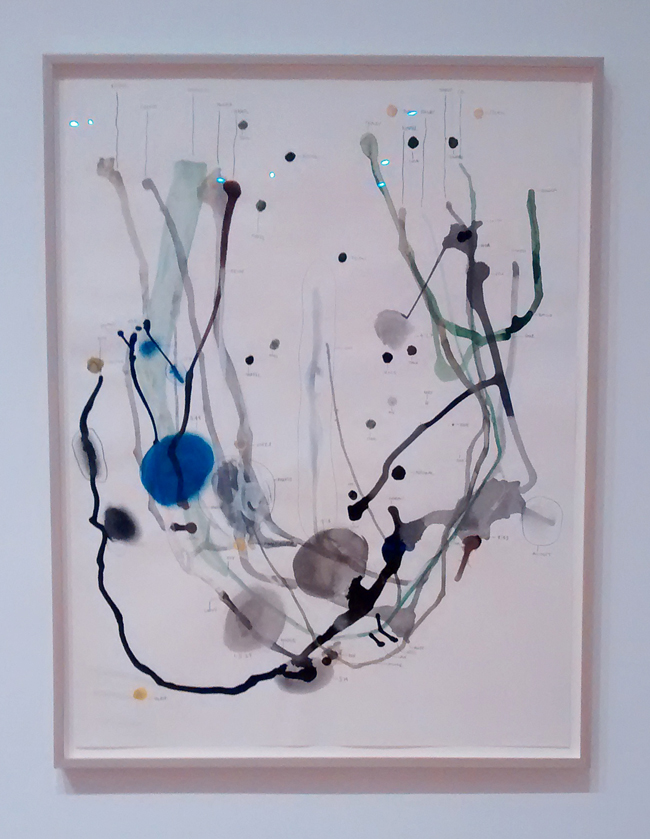
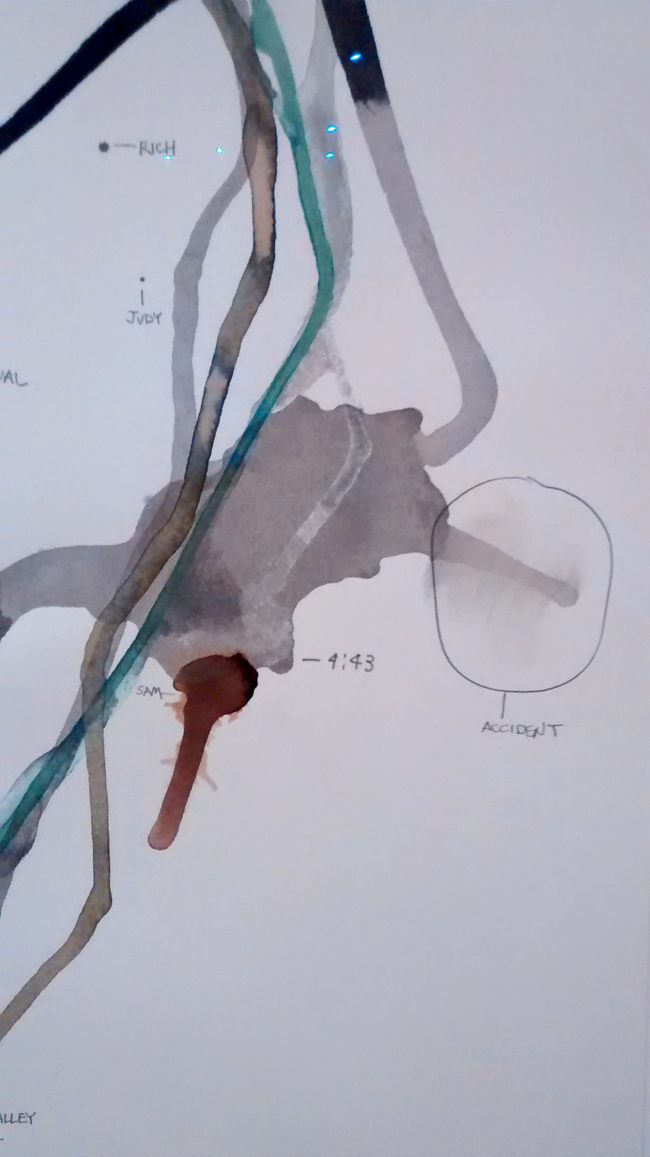 The Peabody Group #29, 1992 (close-up). Graphite pencil, watercolor, gouache, india ink, colored inks, colored pencil, and ballpoint pen on wove paper. The Morgan Library and Museum, New York. Gift of the Modern and Contemporary Collectors Committee.
The Peabody Group #29, 1992 (close-up). Graphite pencil, watercolor, gouache, india ink, colored inks, colored pencil, and ballpoint pen on wove paper. The Morgan Library and Museum, New York. Gift of the Modern and Contemporary Collectors Committee.
Floaters (Pill Heads) 1998. Foamed plastic fishing net floats, acrylic paint, bamboo garden stakes, acrylic mica mortar, and pencil on Formica laminate with wood base mounted on a plastic milk crate. The Estate of Al Taylor, Courtesy David Zwirner, New York/London.
The museum text describes this piece as a variation in Taylor’s “wave theory series… that uses beachcombed fishing net floats to chart the sea’s movement…art historian Klaus Kertess described as ‘Malevich-cum-Lego’.
Taken as a whole with the other mixed media paintings and wall hung constructions, it’s obvious that Taylor got a kick out of assembling oddities and found throwaways into gut wrenching laughter producing art. I wasn’t the only person guffawing in the quiet of a Saturday morning visit. In comparison with similar assemblages of folk art this work presents highly considered spatial experimentation and as the information text notes, “recalibrates the structure of what the eyes see and how the mind comprehends it.”
Bondage Duck #4, 1998-1999. Foamed plastic fishing net floats, rubber bands, latex coating, plastic leis, and bamboo garden stake with acrylic mica mortar mounted on a steel base. Collection of Debbie Taylor.
Thongs, 1989. From the Ten Common (Hawaiian Household) Objects portfolio. Drypoint, sugar-lift aquatint, and spit-bite aquatint printed in black ink on Zerkall Bütten paper; edition 11 of 15.
“What I am after, is just trying to let things make themselves. That’s not as easy as it sounds. It involves devising elaborate programs, systems, and methods which break down, fall apart, and change…taking on meanings and a life outside and beyond my original intentions.” -Al Taylor.
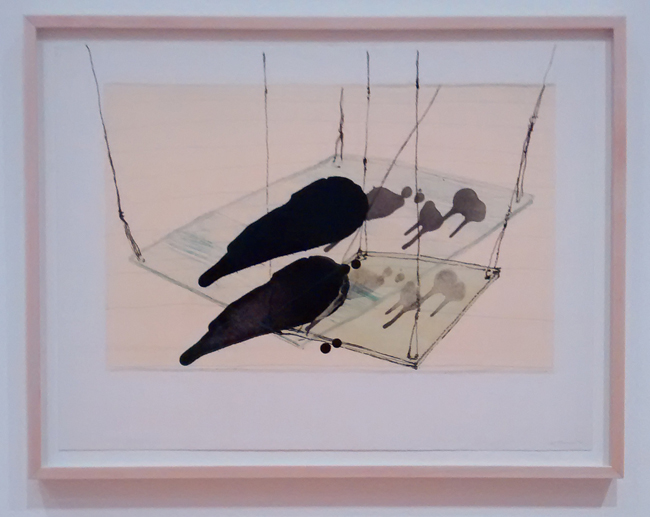 Untitled, 1990. Monotype, Image drawn in pencil and colored litho inks, printed with viscosity tints over solvent transfer on Rives BFK paper. Collection Whitney Museum of American Art, New York.
Untitled, 1990. Monotype, Image drawn in pencil and colored litho inks, printed with viscosity tints over solvent transfer on Rives BFK paper. Collection Whitney Museum of American Art, New York.
In the first monotype above, Taylor used newspaper layering, similar to Rauschenberg’s 1950s process of printmaking. The pet stain motif continues and as the text mentions, the newspaper reminds us of puppy house-training. All too well, for this former dog owner.
Avenue Junot (2) 1990. Xerographic toner fixed with solvent on paper. Private collection, London. Promised gift to The British Museum, Department of Prints and Drawings.
The juxtaposition of this print with André Kertész’s L’Avenue Junot de la maison de Tristan Tzara of 1926 is no accident. In 1990 Taylor spent time in Paris at a friend’s apartment that overlooked the same street. Again, streams of dog urine flowing around the street’s curve captured his imagination. The text states that “Taylor’s two imaginary puddles travel in a similar arcing pathway and converge at the bottom of his composition, where their pool becomes a sequence of loops lifting from the street and suspended in the air – foreshadowing his absurdly commonsensical idea of pet stain removal.” But even knowing nothing about the print’s inspiration, one is charmed by the freeness of the linework and velvety blacks.
L’avenue Junot vue de la maison de Tristan Tzara, 1926. Gelatin silver print, Estate of André Kertész.
Untitled (Tight Turn), 1989. Line etching, spit bite aquatint, open bite etching, and drypoint printed in black ink on Zerkall Bütten paper. Edition 11/15. The Estate of Al Taylor, Courtesy David Zwirner, New York/London.
The text mentions that Taylor was living at Niels Borch Jensen’s print shop in Copenhagen, looked out a kitchen window and spotted an old truck tire hanging on a post set into a garbage can. Proof that Taylor didn’t wait for a monumental muse to strike, he simply used whatever presented itself at any given time of day – anywhere he happened to be. That type of artist is both familiar and rare, content to find interest and even beauty in dirt, dust and old crappy stuff lying around. If an object fell within his field of vision, Taylor utilized the moment to capture and transform. His vision just happened to be challenged (he wore glasses most of his life), but that impairment seems to have only increased his sensitivity.
Untitled: X-Ray Tube, 1995/1997, line etching, spit bite aquatint, and drypoint printed in black ink on Somerset Satin paper. The Estate of Al Taylor, Courtesy David Zwirner, New York/London.
Untitled (Hoop Study), 1993, pencil, gouache, acrylic mica mortar, and correction fluid with collage on paper. Collection of Fred and Nancy Poses, New York.
The New York Times provided this obituary at the time of the artist’s death, noting that: “For many years he painted, but in 1980 he traveled to Africa and returned without enough money to buy canvas to paint on. Inspired by the way children in Africa fashioned toys out of trash, he began working with materials he found on the street. His first three-dimensional works were spare wall pieces made of broomsticks and thin wood slats that resembled skewed architectural models or functionless farm tools. He resisted calling himself a sculptor, expecting to work his way back to paint on canvas.”
No title, 1985, acrylic paint on newsprint. The Estate of Al Taylor, Courtesy David Zwirner, New York/London.
Before Taylor stopped painting in 1985, he worked with acrylic on newsprint or solid grounds in the series above, possibly color studies and ideas for his future constructions.
Al Taylor in Bern, Switzerland, May 1992 (© Martin Müller).
One of the most fun and interesting shows I’ve seen in years, the exhibit ends in two weeks on March 18th, go see it! And don’t miss this great review in Arts ATL by Catherine Fox.

